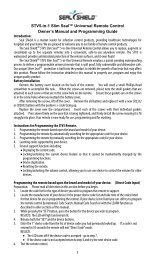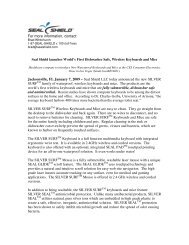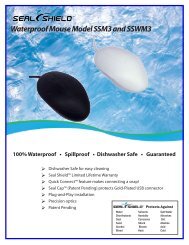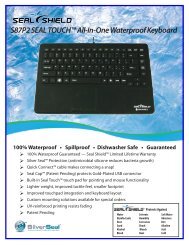Nanocrystalline silver dressings in wound management - Seal Shield
Nanocrystalline silver dressings in wound management - Seal Shield
Nanocrystalline silver dressings in wound management - Seal Shield
Create successful ePaper yourself
Turn your PDF publications into a flip-book with our unique Google optimized e-Paper software.
Fong and Wood<br />
for <strong>wound</strong> <strong>management</strong> either for their antimicrobial or<br />
anti-<strong>in</strong>flammatory properties. More quality cl<strong>in</strong>ical research<br />
should be conducted <strong>in</strong> order to direct cl<strong>in</strong>icians <strong>in</strong> their<br />
decision mak<strong>in</strong>g process <strong>in</strong> choice of <strong>dress<strong>in</strong>gs</strong> and to provide<br />
more evidence for best practices <strong>in</strong> <strong>wound</strong> <strong>management</strong>.<br />
References<br />
Ayton M.1985.Wounds that won’t heal. Nurs<strong>in</strong>g Times, 81:16-19.<br />
Cook N. 1998. Methicill<strong>in</strong> resistant staphylococcus aureus versus the burned<br />
patient. Burns, 24:91–8.<br />
Deitch E, Mar<strong>in</strong> A, Malakanov V, et al. 1987. Silver nylon cloth: <strong>in</strong> vivo and <strong>in</strong><br />
vitro evaluation of antimicrobial activity. J Trauma, 27:301–4.<br />
Deml<strong>in</strong>g R, DeSanti L. 2001. The role of <strong>silver</strong> technology <strong>in</strong> <strong>wound</strong><br />
heal<strong>in</strong>g: Part 1: Effects of <strong>silver</strong> on <strong>wound</strong> <strong>management</strong>. Wounds:<br />
A Compendium of Cl<strong>in</strong>ical Research and Practice, 13(Suppl A):<br />
4–15.<br />
Deml<strong>in</strong>g R, DeSanti L. 2002. The rate of re-epithelialization across meshed<br />
sk<strong>in</strong> grafts is <strong>in</strong>creased with exposure to <strong>silver</strong>. Burns, 28:264–6.<br />
Dunn K, Edwards-Jones V. 2004. The role of Acticoat TM with nanocrystall<strong>in</strong>e<br />
<strong>silver</strong> <strong>in</strong> the <strong>management</strong> of burns. Burns, 30(Supp 1):S1–9.<br />
Fong J. 2005. The use of <strong>silver</strong> products <strong>in</strong> the <strong>management</strong> of burn <strong>wound</strong>s:<br />
change <strong>in</strong> practice for the burn unit at Royal Perth Hospital. Primary<br />
Intention, 13:S16–22.<br />
Fong J, Wood F, Fowler B. 2005. A <strong>silver</strong> coated dress<strong>in</strong>g reduces the<br />
<strong>in</strong>cidence of early burn <strong>wound</strong> cellulitis and associated costs of <strong>in</strong>patient<br />
treatment: Comparative patient care audits. Burns, 31:562–7.<br />
Fraser J, Bodman J, Sturgess R, et al. 2003. An <strong>in</strong> vitro study of the antimicrobial<br />
efficacy of a 1% <strong>silver</strong> sulphadiaz<strong>in</strong>e and 0.2% chlorhexid<strong>in</strong>e<br />
diglugonate cream, 1% <strong>silver</strong> sulphadiaz<strong>in</strong>e cream and a <strong>silver</strong> coated<br />
dress<strong>in</strong>g. Burns, 30:1–7<br />
Fraser J, Cuttle L, Kemp M, et al. 2004. Cytoxicity of topical antimicrobial<br />
agents used <strong>in</strong> burn <strong>wound</strong>s <strong>in</strong> Australasia. ANZ J Surg, 74:139–42.<br />
Heggers J, Goodheart R, Wash<strong>in</strong>gton J, et al. 2005. Therapeutic Efficacy of<br />
three <strong>silver</strong> <strong>dress<strong>in</strong>gs</strong> <strong>in</strong> an <strong>in</strong>fected animal model. J Burn Care Rehabil,<br />
26:53–6.<br />
Heggers J, Hawk<strong>in</strong>s H, Edgar P, et al. 2002. Treatment of <strong>in</strong>fection <strong>in</strong> burns.<br />
In Herndon DN, ed. Total burn cCare. 2nd ed. London: Saunders.<br />
p120–69.<br />
Hoffman S. 1984. Silver sulfadiaz<strong>in</strong>e: an antibacterial agent for topical use<br />
<strong>in</strong> burns. Scand J Plast Reconstr Surgery, 18:119–26.<br />
Holder I, Durkee P, Supp A, et al. 2003. Assessment of a <strong>silver</strong>-coated<br />
barrier dress<strong>in</strong>g for potential use with sk<strong>in</strong> grafts on excised burns.<br />
Burns, 29:445–8.<br />
Innes M, Umraw N, Fish J, et al. 2001. The use of <strong>silver</strong> coated <strong>dress<strong>in</strong>gs</strong><br />
on donor site <strong>wound</strong>s: a prospective, controlled matched pair study.<br />
Burns, 27:621–7.<br />
Kirshner R. 2002. Matrix metalloprote<strong>in</strong>ases <strong>in</strong> normal and impaired<br />
<strong>wound</strong> heal<strong>in</strong>g: A potential role of nanocrystall<strong>in</strong>e <strong>silver</strong>. Wounds: A<br />
Compendium of Cl<strong>in</strong>ical Research and Practice, 13:4–14.<br />
Klasen H. 2000. A historical review of the use of <strong>silver</strong> <strong>in</strong> the treatment of<br />
burns. II. Renewed <strong>in</strong>terest for <strong>silver</strong>. Burns, 26:131–8.<br />
Kumar G, Rameshwar L, Suhas C et al. 1999. Pseudomonas aerug<strong>in</strong>osa<br />
septicaemia <strong>in</strong> burns. Burns, 25:611–16.<br />
Lansdown A. 2002. Silver 1: its antibacterial properties and mechanism of<br />
action. J Wound Care, 11:125–13.<br />
Lansdown A, Williams A, Chandler S, et al. 2005. Silver absorption and<br />
antibacterial efficacy of <strong>silver</strong> <strong>dress<strong>in</strong>gs</strong>. J Wound Care, 14:155–60.<br />
Miller M, 1998. How do I diagnose and treat <strong>wound</strong> <strong>in</strong>fection. Br J Nurs,<br />
7:335–8.<br />
Orv<strong>in</strong>gton L. 2001. The role of <strong>silver</strong> technology <strong>in</strong> <strong>wound</strong> heal<strong>in</strong>g:<br />
Part 2. why is nanocrystall<strong>in</strong>e <strong>silver</strong> superior? Wounds. A<br />
Compendium of Cl<strong>in</strong>ical Research and Practice, 13(Suppl B):<br />
5–10.<br />
Orv<strong>in</strong>gton L. 2004. The truth about <strong>silver</strong>. Ostomy Wound Manage, 50(Suppl<br />
9A):1S–10S.<br />
Poon V, Burd A. 2004. In vitro cytotoxicity of <strong>silver</strong>: implication for cl<strong>in</strong>ical<br />
<strong>wound</strong> care. Burns, 30:140–7.<br />
Rustogi R, Mill J, Fraser J, et al. 2005. The use of Acticoat TM <strong>in</strong> neonatal<br />
burns. Burns, 31:878–82.<br />
Sibbald R, Contreras-Ruiz J, Coutts P, et al. 2005. Open label pilot study of<br />
prolonged release nanocrystall<strong>in</strong>e <strong>silver</strong> dress<strong>in</strong>g (Acticoat 7): reduction<br />
of bacterial burden treatment <strong>in</strong> the treatment of chronic venous leg<br />
ulcers [abstract]. Wound Repair Regen, 13:35.<br />
Sibbald R, Raphael S, Rothman A, et al. 2005. The selective anti-<strong>in</strong>flammatory<br />
activity of prolonged release nanocrystall<strong>in</strong>e <strong>silver</strong> dress<strong>in</strong>g (Acticoat 7)<br />
<strong>in</strong> the treatment of chronic venous leg ulcers [abstract]. Wound Repair<br />
Regen, 13:40.<br />
Smith and Nephew. 2003. Dynamic <strong>silver</strong> release rapid destruction, susta<strong>in</strong>ed<br />
protection, Acticoat with <strong>silver</strong>cryst. Smith and Nephew Pty. Ltd. Product<br />
<strong>in</strong>formation.<br />
Smith and Nephew. 2004.Together at last. Dynamic <strong>silver</strong> and super-powered<br />
absorbency, Acticoat absorbent. Smith and Nephew Pty. Ltd. Product<br />
<strong>in</strong>formation.<br />
Supp A, Needy A, Supp D, et al. 2005. Evaluation of cytotoxicity and<br />
antimicrobial activity of Acticoat burn dress<strong>in</strong>g for <strong>management</strong> of<br />
microbial contam<strong>in</strong>ation <strong>in</strong> cultured sk<strong>in</strong> substitutes grafted to anthymic<br />
mice. J Burn Care Rehabil, 26(3):238–46.<br />
Thomas S. 2003a. A comparison of the antimicrobial effects of four <strong>silver</strong>conta<strong>in</strong><strong>in</strong>g<br />
<strong>dress<strong>in</strong>gs</strong> on three organisms. J Wound Care, 12:101–7.<br />
Thomas S. 2003b. An <strong>in</strong> vitro analysis of the antimicrobial properties of 10<br />
<strong>silver</strong>-conta<strong>in</strong><strong>in</strong>g <strong>dress<strong>in</strong>gs</strong>. J Wound Care, 12:305–9.<br />
Tredget E, Shankovsky R, Groenveld A, et al. 1998. A matched-pair,<br />
randomised study evaluat<strong>in</strong>g the efficacy and safety of Acticoat<br />
<strong>silver</strong>-coated dress<strong>in</strong>g for the treatment of burn <strong>wound</strong>s. J Burn Care<br />
Rehabil, 19:531–7.<br />
Templeton S. 2005. Management of chronic <strong>wound</strong>s:the role of <strong>silver</strong>conta<strong>in</strong><strong>in</strong>g<br />
<strong>dress<strong>in</strong>gs</strong>. Primary Intention, 13:170–9.<br />
Ulkur U, Oncul O, Karagoz H, et al. 2005a. Comparison of <strong>silver</strong>-coated dress<strong>in</strong>g<br />
(Acticoat TM ), chlorhexid<strong>in</strong>e acetate 0.5% (Bactigrass R ), and fusidic acid<br />
2% (Fucid<strong>in</strong>) for topical antibacterial effect <strong>in</strong> methicill<strong>in</strong> resistant<br />
Staphlococci-contam<strong>in</strong>ated, full thickness rat burn <strong>wound</strong>s. Burns,<br />
31:874–7.<br />
Ulkur U, Oncul O, Karagoz H, et al. 2005b. Comparison of <strong>silver</strong>-coated<br />
dress<strong>in</strong>g (Acticoat TM ), chlorhexid<strong>in</strong>e acetate 0.5% (Bactigrass R ),<br />
and sulfadiaz<strong>in</strong>e 1% (Silverd<strong>in</strong>) for topical antibacterial effect <strong>in</strong><br />
Pseudomonas aerug<strong>in</strong>osa contam<strong>in</strong>ated, full thickness burn <strong>wound</strong> <strong>in</strong><br />
rats. J Burn Care Rehabil, 26:430–3.<br />
Varas R, O’Keefe T, Namia N, et al. 2005. A prospective, randomized<br />
trial of Acticoat versus <strong>silver</strong> sulfadiaz<strong>in</strong>e <strong>in</strong> the treatment of partial<br />
thickness burns: which method is less pa<strong>in</strong>ful? J Burn Care and Rehabil,<br />
26:344–7.<br />
Voight D, Paul C. 2001. The use of Acticoat as <strong>silver</strong> impregnated Telfa<br />
<strong>dress<strong>in</strong>gs</strong> <strong>in</strong> a Regional burn and <strong>wound</strong> care center: the cl<strong>in</strong>icians<br />
view. Wounds: A Compendium of Cl<strong>in</strong>ical Research and Practice,<br />
13:11–23.<br />
Wright J, Lam K, Burrell R. 1998. Wound <strong>management</strong> <strong>in</strong> an era of <strong>in</strong>creas<strong>in</strong>g<br />
bacterial antibiotic resistance: a role for topical <strong>silver</strong> treatment. Am J<br />
Infect Control, 26:572–7.<br />
White R, Cooper R, K<strong>in</strong>gsley A. 2002. A topical issue: the use of antibacterials<br />
<strong>in</strong> <strong>wound</strong> pathogen control. In White R, ed. Trends <strong>in</strong> <strong>wound</strong> care. UK:<br />
Bath Press. p16–17.<br />
Woodward M. 2005. Silver <strong>dress<strong>in</strong>gs</strong> <strong>in</strong> <strong>wound</strong> heal<strong>in</strong>g: what is the evidence?<br />
Primary Intention, 13:153–60.<br />
Wright B, Lam K, Hansen D, et al. 1999. Efficacy of topical <strong>silver</strong> aga<strong>in</strong>st<br />
fungal burn <strong>wound</strong> pathogens. Am J of Infect Control, 27:344–50.<br />
Wright B, Lam K, Buret A, et al. 2002. Early heal<strong>in</strong>g events <strong>in</strong> a porc<strong>in</strong>e<br />
model of contam<strong>in</strong>ated <strong>wound</strong>s: effects of nanocrystall<strong>in</strong>e <strong>silver</strong> on<br />
matrix metalloprote<strong>in</strong>ases, cell apoptosis, and heal<strong>in</strong>g. Wound Repair<br />
Regen, 10:141–51.<br />
448<br />
International Journal of Nanomedic<strong>in</strong>e 2006:1(4)







